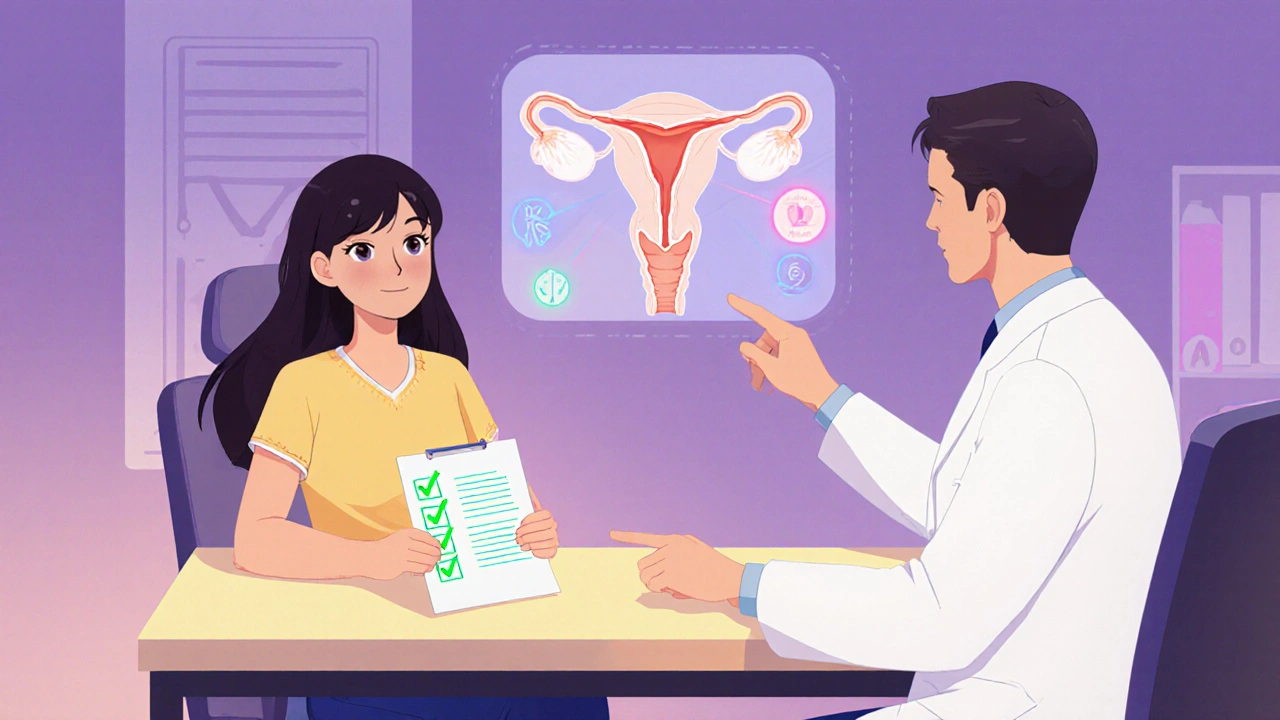Contraception and Cancer Risk: What the Research Shows

Contraception Cancer Risk Calculator
Understand Your Risk
This calculator estimates how different contraceptive methods may affect your relative risk of certain cancers based on scientific studies. All data comes from the article "Contraception and Cancer Risk: What the Research Shows".
Your Estimated Risk Changes
Breast Cancer Risk
Based on current use data
Ovarian Cancer Risk
Based on 5+ year use data
Endometrial Cancer Risk
Based on 5+ year use data
When you hear the word contraception, your mind might jump to preventing pregnancy, but a growing number of people also wonder how birth control could affect cancer risk. The answer isn’t a simple yes or no - it depends on the method, the hormones involved, and your own health profile.
Quick Takeaways
- Combined hormonal contraceptives (estrogen + progestin) slightly raise breast‑cancer risk while lowering ovarian and endometrial cancer risk.
- Progestin‑only pills, implants, and hormonal IUDs have a smaller impact on breast cancer and still protect against ovarian cancer.
- Non‑hormonal methods (copper IUD, condoms, sterilization) show no clear link to increased cancer risk.
- Risk changes are modest; the absolute increase for most women is less than 1 extra case per 10,000 users per year.
- Individual choices should balance cancer risk with other factors like contraception efficacy, side‑effects, and personal preferences.
What Is Contraception?
Contraception is a set of methods used to prevent pregnancy. These methods fall into two broad families: hormonal (e.g., oral contraceptive pills, hormonal IUDs, patches, implants) and non‑hormonal (e.g., copper IUD, condoms, diaphragms, sterilization). Hormonal options work by delivering synthetic versions of estrogen and/or progestin to suppress ovulation, thin the uterine lining, or thicken cervical mucus.
How Is Cancer Risk Evaluated?
Researchers use large cohort studies, case‑control analyses, and meta‑analyses to compare cancer incidence among users versus non‑users. Key metrics include relative risk (RR) or odds ratio (OR). An RR of 1.0 means no difference; above 1.0 signals increased risk, below 1.0 suggests protection. Most modern studies adjust for age, smoking, family history, and hormone‑related factors to isolate the effect of contraception.
Breast Cancer and Hormonal Contraceptives
Breast tissue is sensitive to estrogen. Combined oral contraceptives (COCs) contain both estrogen and progestin, which can modestly stimulate cell proliferation. A 2023 meta‑analysis of 75 studies (over 30 million women) found a pooled RR of 1.20 for current COC users-meaning a 20 % relative increase while the pill is being taken. The risk returns to baseline within about 10 years after stopping.
Progestin‑only pills (POP), hormonal implants, and intrauterine systems (IUS) show either no increase or a very small rise (RR ≈ 1.05). The differences stem from lower estrogen exposure.
Ovarian and Endometrial Cancer: A Protective Effect
Both ovarian and endometrial cancers thrive on repeated ovulation and unopposed estrogen. By suppressing ovulation and creating a consistent hormonal environment, hormonal contraception dramatically lowers the odds of these cancers. Long‑term COC users (≥5 years) experience a 30-50 % reduction in ovarian cancer risk (RR ≈ 0.6) and a 40 % reduction in endometrial cancer risk (RR ≈ 0.6). The protective benefit can persist for decades after discontinuation.
Cervical Cancer: The Role of HPV and Hormones
Cervical cancer is primarily driven by persistent human papillomavirus (HPV) infection. Some studies suggest that long‑term hormonal contraception may slightly increase the risk of high‑grade cervical lesions (RR ≈ 1.2), likely because hormones can affect the local immune environment. However, regular HPV vaccination and screening outweigh any modest contraceptive effect.
Non‑Hormonal Methods and Cancer Risk
Devices that do not release hormones-copper IUDs, male/female condoms, diaphragms, and sterilization-have not been linked to any meaningful change in cancer incidence. Their safety profile makes them a solid option for anyone concerned about hormone‑related risks.
Comparing Contraception Types and Cancer Risks
| Contraception Type | Hormone Content | Breast Cancer | Ovarian Cancer | Endometrial Cancer | Cervical Cancer |
|---|---|---|---|---|---|
| Combined oral pills | Estrogen + Progestin | ↑ ~20 % (current use) | ↓ ~40 % (≥5 yr) | ↓ ~40 % (≥5 yr) | ↑ ~10‑15 % (long‑term) |
| Progestin‑only pill | Progestin only | No significant change | ↓ ~20‑30 % | ↓ ~20‑30 % | No clear effect |
| Hormonal IUD (e.g., LNG‑IUS) | Low‑dose progestin | Minor ↑ or neutral | ↓ ~20 % | ↓ ~30 % | Neutral |
| Copper IUD | None | Neutral | Neutral | Neutral | Neutral |
| Condoms (male/female) | None | Neutral | Neutral | Neutral | Neutral |

Practical Guidance for Choosing a Method
- Assess your personal risk factors. Family history of breast or ovarian cancer, personal hormonal sensitivities, and BMI all matter.
- Consider how long you plan to use the method. Longer use of combined pills amplifies both the slight breast‑cancer rise and the ovarian‑cancer protection.
- Factor in non‑cancer concerns: menstrual changes, weight gain, bone health, and convenience.
- Talk to your healthcare provider about HPV vaccination and regular Pap smears; they dramatically lower cervical‑cancer risk regardless of contraception.
- If you prefer zero hormonal exposure, a copper IUD or condoms are safe and effective alternatives.
Common Myths Debunked
Myth: “The pill causes cancer for everyone.”
Fact: The absolute increase in breast‑cancer cases is very small-often less than one extra case per 10,000 users per year. For most women, the overall health benefits outweigh this risk.
Myth: “IUDs lead to uterine cancer.”
Fact: Hormonal IUDs actually reduce endometrial cancer risk by thinning the lining.
Myth: “If I stop the pill, my risk instantly returns to normal.”
Fact: Breast‑cancer risk returns to baseline within about 10 years, while ovarian‑cancer protection can linger for decades.
Checklist Before Starting or Switching
- Review personal and family cancer history.
- Know whether you’ll be using the method for <10 years or longer.
- Confirm you’re up‑to‑date on HPV vaccination and cervical screening.
- Discuss side‑effects unrelated to cancer (e.g., mood changes, weight).
- Re‑evaluate annually with your clinician.
Frequently Asked Questions
Does the birth control pill increase my chance of getting breast cancer?
Current users of combined oral contraceptives have a modest relative increase (about 20 %) in breast‑cancer risk. In absolute terms, this translates to roughly 1 extra case per 10,000 women per year. The risk drops after you stop using the pill and returns to baseline after about 10 years.
Can hormonal contraception protect me from ovarian cancer?
Yes. Long‑term use (five years or more) of combined estrogen‑progestin pills or hormonal IUDs reduces ovarian‑cancer risk by roughly 40 %. The protective effect can last for many years after discontinuation.
Do non‑hormonal methods affect cancer risk at all?
Research shows no meaningful association between non‑hormonal methods (copper IUD, condoms, sterilization) and any type of cancer. They remain a safe choice for those wanting to avoid hormones.
Should I get an IUD if I’m worried about breast cancer?
A hormonal IUD releases a low dose of progestin and carries a much smaller breast‑cancer signal than combined pills. Many experts consider it a reasonable middle ground if you want hormonal contraception but are concerned about estrogen exposure.
How often should I revisit my contraception choice?
At least once a year, or sooner if you develop new health issues, change your family‑planning goals, or receive new screening results. Your clinician can help weigh any updated cancer‑risk data against your lifestyle needs.
Understanding the nuanced relationship between contraception and cancer empowers you to make choices that align with both your reproductive goals and long‑term health. While hormones can nudge risk numbers up or down, the overall impact is modest, and many methods also provide strong protection against other cancers. Keep the conversation open with your healthcare team, stay current on screenings, and pick the method that feels right for you.






Lyle Mills
October 18, 2025 AT 18:48Understanding the risk differentials requires parsing relative risk metrics and absolute incidence rates. The estrogen‑progestin synergy modulates mammary epithelial proliferation via estrogen receptor signaling pathways. Meanwhile ovarian epithelium benefits from anovulation‑induced reduction in gonadotropin exposure which translates into lower proliferative stimulus. The data suggest a transient 20 % increase in breast cancer relative risk during active combined oral contraceptive use with a return to baseline within a decade post‑cessation. Clinicians should contextualize this modest absolute risk when counseling patients with baseline risk factors.
Barbara Grzegorzewska
October 25, 2025 AT 17:28Honestly, the whole “pill kills you” hysteria is pure drivel fed by anti‑science zealots who cant handle a little estrogen. In the US we’ve got top‑tier research that proves the benefits outweigh the negligible uptick in breast cancer. If you’re whining about “risk,” just read the meta‑analysis instead of scrolling TikTok. America leads in reproductive health, so stop crying over baseless myths.
Nis Hansen
November 1, 2025 AT 15:08When we contemplate contraception, we are really weighing the delicate balance between personal autonomy and long‑term health trajectories. The data on hormonal birth control remind us that every intervention carries a marginal shift in risk, not an absolute destiny. A 20 % relative increase in breast cancer risk while using combined oral contraceptives translates to a handful of cases per ten thousand women, a statistic that can be contextualized against baseline incidence. Simultaneously, the same hormonal milieu confers a 40 % reduction in ovarian and endometrial cancer, benefits that may persist for decades after discontinuation. This duality exemplifies the principle that medical choices are rarely black and white but rather a spectrum of trade‑offs. From a philosophical standpoint, we might ask whether the fear of a modest increase outweighs the tangible protection against other, often deadlier cancers. Encountering this dilemma invites us to practice practical wisdom, or phronesis, integrating empirical evidence with our values and life circumstances. For a woman with a strong family history of breast cancer, the modest rise may tip the scales toward non‑hormonal methods. Conversely, for someone seeking reliable contraception and relief from menstrual disorders, the hormonal route may be the most rational path. It is also crucial to acknowledge that lifestyle factors-smoking, BMI, physical activity-interact with hormonal exposure in shaping cancer risk. Therefore, the conversation with a healthcare provider should be holistic, covering not only the pill but also diet, exercise, and screening schedules. Empowerment arises when individuals understand that the absolute risk increase is less than one additional case per ten thousand per year. Knowledge transforms fear into informed decision‑making, and that is the true safeguard against disease. As we navigate these choices, we should celebrate the scientific progress that allows us to quantify such nuanced outcomes. Let us then approach contraception not as a gamble but as a calibrated strategy aligned with personal health goals. In doing so, we honor both our bodily autonomy and our responsibility to future well‑being.
Fabian Märkl
November 8, 2025 AT 13:48Great breakdown! It really helps to see the numbers in plain language 🙂. If you’re on the fence, remember that the protective effects on ovarian and endometrial cancer are pretty solid, and the breast‑cancer bump is tiny. Talk openly with your doctor and weigh the personal factors that matter most. You’ve got this, and the right choice will fit your lifestyle.
Avril Harrison
November 15, 2025 AT 12:28Just a heads‑up that the non‑hormonal options like copper IUDs and condoms are completely neutral when it comes to cancer risk. They’re a solid fallback if you want to dodge hormones altogether. Also, make sure you stay on top of regular screenings no matter what you pick.
Natala Storczyk
November 22, 2025 AT 11:08Listen up, America!! We don’t need European nonsense about “natural” methods when our own scientists have proven hormonal birth control saves lives!! The data is crystal clear, and if you’re still scared, you’re just buying into hysteria!! Get your facts straight and stop letting fear dictate your health!!
Sarah Hanson
November 29, 2025 AT 09:48Dear community, I appreciate the thorough discussion presented here. It is essential that each individual evaluates personal and familial risk factors before deciding on a contraceptive method. Please remember to schedule routine screenings and consult healthcare professionals for tailored advice. Definately, staying informed is the best protection. Thank you for your attention.
kendra mukhia
December 6, 2025 AT 08:28Honestly, the so‑called “balanced” approach you mention is just bland mediocrity. The science is crystal clear: hormonal contraception is a double‑edged sword, and you’re glossing over the subtle dangers! If you truly care about your health, you’d demand a deeper dive into the hormonal pathways rather than spewing generic advice.
Grace Hada
December 13, 2025 AT 07:08The underlying truth is simple: risk is a statistical construct, not a moral verdict. Accept the data without melodrama.